The Unmanned Aerial Vehicle Market is estimated to be valued at USD 29.1 billion in 2025 and is projected to reach USD 96.1 billion by 2035, registering a compound annual growth rate (CAGR) of 12.7% over the forecast period.
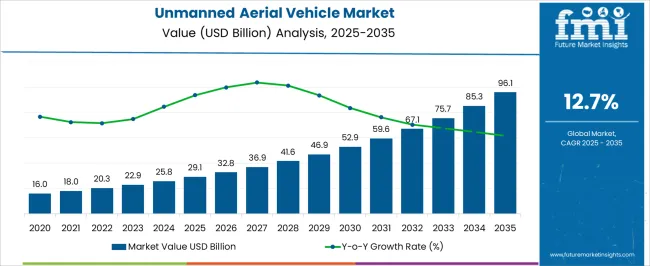
| Metric | Value |
|---|---|
| Unmanned Aerial Vehicle Market Estimated Value in (2025 E) | USD 29.1 billion |
| Unmanned Aerial Vehicle Market Forecast Value in (2035 F) | USD 96.1 billion |
| Forecast CAGR (2025 to 2035) | 12.7% |
The Unmanned Aerial Vehicle market is experiencing substantial growth, driven by increasing adoption across defense, commercial, and civil sectors. Rising demand for tactical and operational surveillance, reconnaissance missions, and industrial inspections is contributing to market expansion. Technological advancements in flight control systems, autonomous navigation, and sensor integration are enhancing UAV performance, reliability, and operational efficiency.
Battery-operated UAVs are gaining traction due to improved energy density, lightweight designs, and lower operational costs, supporting wider deployment. Growth is further supported by increasing investments in smart agriculture, infrastructure monitoring, logistics, and emergency response applications. Regulatory developments and airspace integration standards are shaping the market landscape, ensuring safe and compliant operations.
As organizations continue to prioritize real-time data collection, situational awareness, and cost-effective operational solutions, the UAV market is expected to experience sustained growth Innovations in endurance, payload capacity, and AI-enabled autonomous capabilities are anticipated to open new opportunities for both military and commercial applications over the coming decade, further solidifying the market’s long-term expansion potential.
The unmanned aerial vehicle market is segmented by class, energy source, endurance, payload, wing type, applications, and geographic regions. By class, unmanned aerial vehicle market is divided into Tactical, Small, and Strategic. In terms of energy source, unmanned aerial vehicle market is classified into Battery Operated, Hydrogen, Solar, and Hybrid. Based on endurance, unmanned aerial vehicle market is segmented into Medium (5 Hrs - 24 Hrs), Short (< 5 Hrs), and High (> 24 Hrs). By payload, unmanned aerial vehicle market is segmented into Synthetic Aperture Radars (SARs), EW Systems, Electro-Optic Infrared Sensors (EO/IR), and C4I Systems. By wing type, unmanned aerial vehicle market is segmented into Fixed Wing, Tilt Wing, Unmanned Helicopter, and Multicopter. By applications, unmanned aerial vehicle market is segmented into Military, Commercial, and Homeland Security. Regionally, the unmanned aerial vehicle industry is classified into North America, Latin America, Western Europe, Eastern Europe, Balkan & Baltic Countries, Russia & Belarus, Central Asia, East Asia, South Asia & Pacific, and the Middle East & Africa.
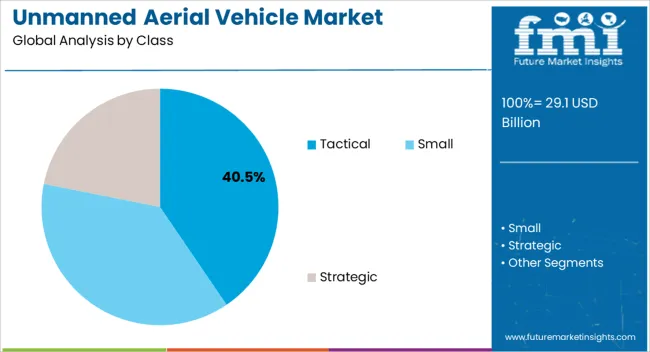
The tactical class segment is projected to hold 40.5% of the UAV market revenue in 2025, establishing it as the leading class. Growth in this segment is being driven by the increasing need for versatile UAVs capable of performing multiple mission types, including surveillance, reconnaissance, and intelligence gathering. Tactical UAVs offer flexibility, scalability, and rapid deployment capabilities, making them highly suitable for defense operations and critical infrastructure monitoring.
Their modular design and payload adaptability allow integration of advanced sensors, communication modules, and imaging systems to support diverse applications. The ability to operate in challenging environments while maintaining reliability and mission efficiency has reinforced their adoption among defense and security agencies.
As demand for cost-effective yet high-performance UAVs continues to rise, tactical UAVs are expected to maintain their leadership position, supported by advancements in autonomous navigation, real-time data processing, and operational control systems Enhanced survivability, operational endurance, and multi-role functionality continue to drive preference for this class.
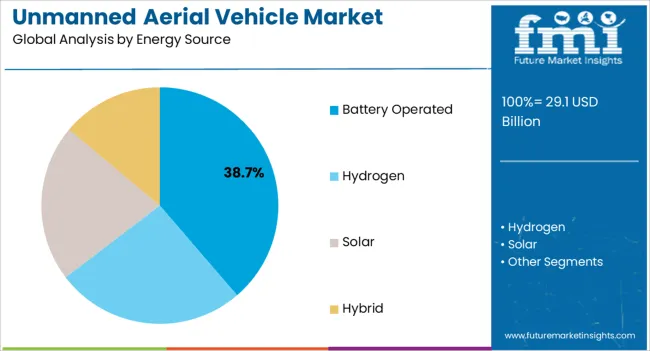
The battery-operated segment is anticipated to account for 38.7% of the UAV market revenue in 2025, making it the leading energy source. Growth in this segment is driven by advancements in high-capacity lithium-ion and lithium-polymer battery technologies, which have improved flight time, reliability, and safety. Battery-operated UAVs provide lower operational costs, reduced maintenance requirements, and simplified logistics compared to conventional fuel-based alternatives.
These UAVs are increasingly adopted across defense, commercial, and research applications where portability, silent operation, and rapid deployment are critical. Energy-efficient designs, lightweight materials, and optimized propulsion systems further enhance battery performance. The integration of battery-operated UAVs with AI-enabled power management systems allows extended mission capabilities without frequent recharging.
As environmental sustainability and operational efficiency become priorities, battery-operated UAVs are expected to dominate market adoption Increasing demand for electric propulsion in both small and medium-sized UAVs is reinforcing their position as the preferred energy source, supported by continuous innovation in energy density and battery lifecycle management.
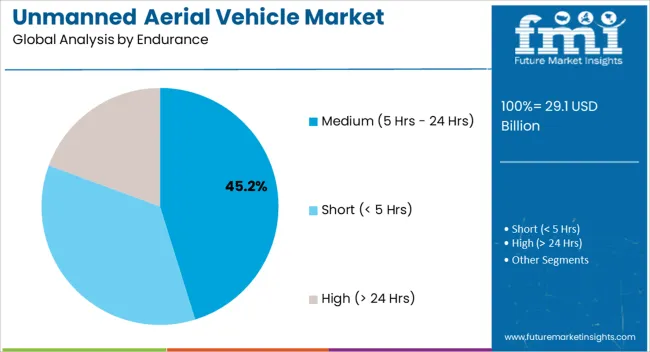
The medium endurance segment, defined by flight durations between 5 hours and 24 hours, is projected to hold 45.2% of the UAV market revenue in 2025, establishing it as the leading endurance category. Growth in this segment is driven by the need for UAVs capable of sustained missions without frequent refueling or battery replacement, making them suitable for both military and commercial applications. Medium endurance UAVs enable extended surveillance, reconnaissance, and data collection operations while maintaining operational efficiency and safety.
The ability to balance payload capacity, flight range, and operational flexibility makes this endurance range ideal for intelligence, environmental monitoring, and infrastructure inspections. Advancements in battery technology, energy management systems, and lightweight structural materials have enhanced mission duration and reliability.
Increasing adoption in sectors requiring long-duration flight capabilities, such as border security, disaster management, and precision agriculture, is further supporting growth As organizations prioritize operational continuity and cost-effective long-duration deployments, medium endurance UAVs are expected to remain the primary choice, sustaining their market dominance.
The unmanned aerial vehicle market is experiencing steady growth, with a projected market size of USD 25.8 billion in 2025. The positive trend is expected to continue, with the market reaching an estimated USD 83.6 billion by 2035. The market is likely to ascend at a CAGR of 12.7% over the next decade.
A key trend in the unmanned aerial vehicle market is the rapid advancement in drone autonomy. With significant strides in artificial intelligence and machine learning, modern unmanned aerial vehicles are increasingly capable of operating without human intervention.
Autonomous drones are now equipped with advanced sensors and real time data processing capabilities, enabling them to perform complex tasks such as surveillance, mapping, and even package delivery with high precision.
The above trend is driven by the demand for efficiency and safety in various industries, including agriculture, logistics, and defense. The integration of artificial intelligence allows unmanned aerial vehicles to navigate challenging environments, avoid obstacles, and make real time decisions, significantly reducing the need for human oversight.
Businesses are experiencing lower operational costs and enhanced productivity, fueling the growth of the unmanned aerial vehicle industry and paving the way for more innovative applications in the future.
| Attributes | Details |
|---|---|
| Unmanned Aerial Vehicle Market Size (2025E) | USD 25.8 billion |
| Unmanned Aerial Vehicle Market Projected Size (2035F) | USD 83.6 billion |
| Value CAGR (2025 to 2035) | 12.7% |
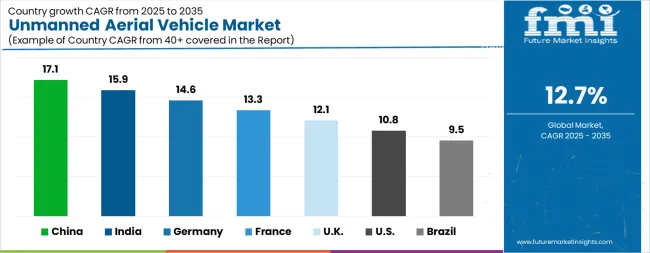
| Country | CAGR |
|---|---|
| China | 17.1% |
| India | 15.9% |
| Germany | 14.6% |
| France | 13.3% |
| UK | 12.1% |
| USA | 10.8% |
| Brazil | 9.5% |
The Unmanned Aerial Vehicle Market is expected to register a CAGR of 12.7% during the forecast period, exhibiting varied country level momentum. China leads with the highest CAGR of 17.1%, followed by India at 15.9%. Developed markets such as Germany, France, and the UK continue to expand steadily, while the USA is likely to grow at consistent rates. Brazil posts the lowest CAGR at 9.5%, yet still underscores a broadly positive trajectory for the global Unmanned Aerial Vehicle Market. In 2024, Germany held a dominant revenue in the Western Europe market and is expected to grow with a CAGR of 14.6%. The USA Unmanned Aerial Vehicle Market is estimated to be valued at USD 10.2 billion in 2025 and is anticipated to reach a valuation of USD 28.4 billion by 2035. Sales are projected to rise at a CAGR of 10.8% over the forecast period between 2025 and 2035. While Japan and South Korea markets are estimated to be valued at USD 1.4 billion and USD 797.3 million respectively in 2025.
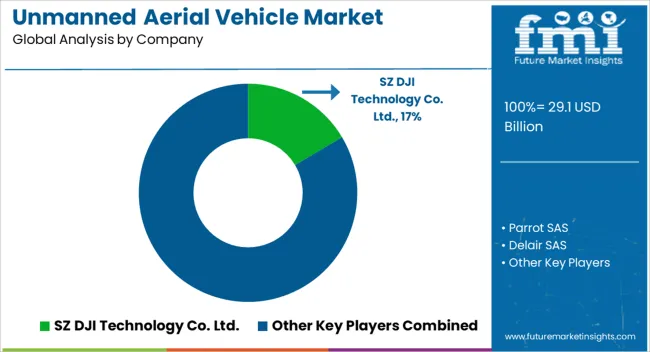
| Item | Value |
|---|---|
| Quantitative Units | USD 29.1 Billion |
| Class | Tactical, Small, and Strategic |
| Energy Source | Battery Operated, Hydrogen, Solar, and Hybrid |
| Endurance | Medium (5 Hrs - 24 Hrs), Short (< 5 Hrs), and High (> 24 Hrs) |
| Payload | Synthetic Aperture Radars (SARs), EW Systems, Electro-Optic Infrared Sensors (EO/IR), and C4I Systems |
| Wing Type | Fixed Wing, Tilt Wing, Unmanned Helicopter, and Multicopter |
| Applications | Military, Commercial, and Homeland Security |
| Regions Covered | North America, Europe, Asia-Pacific, Latin America, Middle East & Africa |
| Country Covered | United States, Canada, Germany, France, United Kingdom, China, Japan, India, Brazil, South Africa |
| Key Companies Profiled | SZ DJI Technology Co. Ltd., Parrot SAS, Delair SAS, AeroVironment, Inc., Northrop Grumman Corporation, Elbit Systems Ltd., General Atomics, Israel Aerospace Industries Ltd., THALES, The Boeing Company, Microdrones GmbH (mdGroup Germany GmbH), BAYKAR TECH, Leonardo S.p.A, and Textron Inc. |
The global unmanned aerial vehicle market is estimated to be valued at USD 29.1 billion in 2025.
The market size for the unmanned aerial vehicle market is projected to reach USD 96.1 billion by 2035.
The unmanned aerial vehicle market is expected to grow at a 12.7% CAGR between 2025 and 2035.
The key product types in unmanned aerial vehicle market are tactical, small and strategic.
In terms of energy source, battery operated segment to command 38.7% share in the unmanned aerial vehicle market in 2025.






Our Research Products

The "Full Research Suite" delivers actionable market intel, deep dives on markets or technologies, so clients act faster, cut risk, and unlock growth.

The Leaderboard benchmarks and ranks top vendors, classifying them as Established Leaders, Leading Challengers, or Disruptors & Challengers.

Locates where complements amplify value and substitutes erode it, forecasting net impact by horizon

We deliver granular, decision-grade intel: market sizing, 5-year forecasts, pricing, adoption, usage, revenue, and operational KPIs—plus competitor tracking, regulation, and value chains—across 60 countries broadly.

Spot the shifts before they hit your P&L. We track inflection points, adoption curves, pricing moves, and ecosystem plays to show where demand is heading, why it is changing, and what to do next across high-growth markets and disruptive tech

Real-time reads of user behavior. We track shifting priorities, perceptions of today’s and next-gen services, and provider experience, then pace how fast tech moves from trial to adoption, blending buyer, consumer, and channel inputs with social signals (#WhySwitch, #UX).

Partner with our analyst team to build a custom report designed around your business priorities. From analysing market trends to assessing competitors or crafting bespoke datasets, we tailor insights to your needs.
Supplier Intelligence
Discovery & Profiling
Capacity & Footprint
Performance & Risk
Compliance & Governance
Commercial Readiness
Who Supplies Whom
Scorecards & Shortlists
Playbooks & Docs
Category Intelligence
Definition & Scope
Demand & Use Cases
Cost Drivers
Market Structure
Supply Chain Map
Trade & Policy
Operating Norms
Deliverables
Buyer Intelligence
Account Basics
Spend & Scope
Procurement Model
Vendor Requirements
Terms & Policies
Entry Strategy
Pain Points & Triggers
Outputs
Pricing Analysis
Benchmarks
Trends
Should-Cost
Indexation
Landed Cost
Commercial Terms
Deliverables
Brand Analysis
Positioning & Value Prop
Share & Presence
Customer Evidence
Go-to-Market
Digital & Reputation
Compliance & Trust
KPIs & Gaps
Outputs
Full Research Suite comprises of:
Market outlook & trends analysis
Interviews & case studies
Strategic recommendations
Vendor profiles & capabilities analysis
5-year forecasts
8 regions and 60+ country-level data splits
Market segment data splits
12 months of continuous data updates
DELIVERED AS:
PDF EXCEL ONLINE
Unmanned Aerial Vehicles (UAV) Commercial Drone Market Size and Share Forecast Outlook 2025 to 2035
Unmanned Systems Market Analysis - Size, Share, & Forecast Outlook 2025 to 2035
Unmanned Marine Vehicles Market Size and Share Forecast Outlook 2025 to 2035
Unmanned Ground Vehicle Market Size and Share Forecast Outlook 2025 to 2035
Unmanned Railway Vehicle Washing Systems Market Size and Share Forecast Outlook 2025 to 2035
Unmanned Surface Vehicle Market Size and Share Forecast Outlook 2025 to 2035
Aerial Work Platforms Market Size and Share Forecast Outlook 2025 to 2035
Aerial Firefighting Market Size and Share Forecast Outlook 2025 to 2035
Aerial Ladder Trucks Market Size and Share Forecast Outlook 2025 to 2035
Competitive Overview of Aerial Imaging Market Share
Aerial Imaging Market Growth - Trends & Forecast 2025 to 2035
UK Aerial Imaging Market Trends – Demand, Innovations & Forecast 2025-2035
UK Aerial Work Platform Market Analysis – Size & Growth Forecast 2025-2035
USA Aerial Work Platform Market Insights – Demand, Size & Industry Trends 2025-2035
USA Aerial Imaging Market Analysis – Size & Industry Trends 2025-2035
Smart Aerial Work Robots Market Size and Share Forecast Outlook 2025 to 2035
BRICS Aerial Work Platforms Market Size and Share Forecast Outlook 2025 to 2035
Korea Aerial Work Platform MarketGrowth - Trends & Forecast 2025 to 2035
Japan Aerial Work Platform Market Growth – Innovations & Therapies 2025 to 2035
Japan Aerial Imaging Market Report – Trends & Innovations 2025-2035

Thank you!
You will receive an email from our Business Development Manager. Please be sure to check your SPAM/JUNK folder too.
Chat With
MaRIA